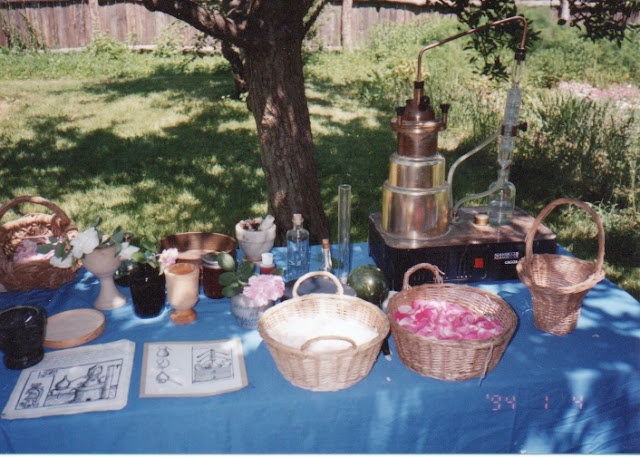are
as
sweet
as a greenhouse
on a rainy day.
Russell Gardens, growers par excellence in our area, has a rabbit-warren of herb houses to poke through, one treasure after another: the extra-warm basil house and the hidden scented-geraniums-- masters of mimicry: rose, lemon. grapefruit. The rest of the offerings, alphabetized, present a scratch-and-sniff wonderment, serenaded by the drip and splash of a misty rain, seeping through the seams of these patchwork buildings. Ah. The fragrance of heaven!
Its always good to remember to bring the photographer,
and hope for a few great shots from the master.
 |
| The fringed french lavenders are too tender to survive the winter unprotected in my Pennsylvania gardens |
Hurrah!
I have come in search of
more lavender for my sunny
next-door garden, where some four year old english intermedia lavenders, Grappenhall, have been growing into sturdy shrubs. In the greenhouse, these look unimpressive now, but I add them to my purchase, along with some flashy-sounding "Elegance Purple" lavenders that bloom July - September and three woody lemon-verbena that will go in pots on the porch.
Its really to early yet for the warmth-loving plants to be happily transplanted into the soil -- I'll wait to put in the basils and tomatoes and dipper gourds from seed another tw week, perhaps. They can languish here in the care of these experts better than in my makeshift protections at home or at the CSA farm, and will provide another reason to stop on my way home from chemo.
http://www.ces.ncsu.edu/fletcher/programs/herbs/crops/culinary/lavender_mccoy.html More excellent information on the intricacies of lavender hybrid may be found on this website from North Carolina. (and another Jeanine at work!)
Its not yet raining in earnest when I get home, so I water my flat of new babies,
-- never trust the weather report --
knowing that they will need a couple days for hardening off -- getting used to the great outdoors,
as they have been cosseted inside up til now. I'll sit them outside, but bring them in if the evening turns cold...pampering them for a bit more while readying their permanent homes in the garden.
I think its mostly the wind and the pelting rain that makes them grow stronger. I remember reading some amazing dry science paper on how the pressure of the wind stimulated both root and stem modifications: http://www.amjbot.org/content/93/10/1546.full. Ah. Wonders of the Web!
The gist of it was that the environmental stressors unleashed specific chemical changes the created structural modifications as a response. And that these plants are then less likely to be uprooted in areas where they are grazed, or to top-kill in drought situations: cool. huh? Anyway, being a philosopher/scientist sort leads me to see this as a metaphor, is not an actual hint, as to the effects of stressors on the production of adaptable and resilient offspring, generally. As in children... perhaps these hovering parents (helicopter parents) that are overinvested in their children should be called greenhouse parents... and we should be given "hardening-off" instructions for our teens to twenty-somethings, as well... eh?
The preparations for perennial beds should be more extensive than the prep for annual beds.
The Grappenhalls, after all, will be in their new home for years, growing to a robust 4'. They are hardy to zone 5, as is Munstead, another English favorite, and given proper soils and drainage will lay in those beds for decades. They will produce more essential oils in a sand or stone mulch, rather than a vegetative mulch, which tends to hold moisture. All lavenders appreciate a Ph of 6.5 - 7.5., so test and lime as needed. Try to give them a sweet, sandy, sunny spot, for they will not suffer wet feet gladly.


























